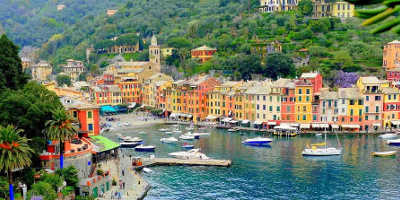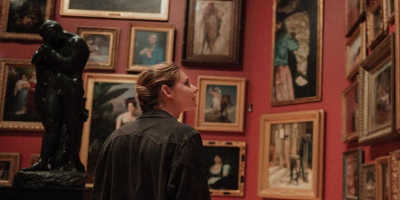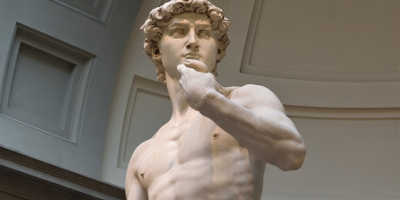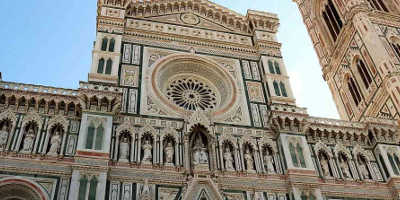Uffizi Gallery (Gallerie Degli Uffizi), Florence
Take a tour through Italian art history at one of the most incredible galleries in Europe.
One of Italy’s finest art galleries, the Uffizi showcases some of the world’s most spectacular paintings and priceless pieces of art. Established in 1581, it houses 45 museum halls that boast of the same lavish attention to detail that went into the curation of wonderful artworks conveying the gothic ideal of beauty.
The Uffizi gallery was designed by Vasari, an architect, and author, who envisioned an exhibition hall that would forever leave its mark on the visitors with its splendid architecture and enthralling exhibits! And to make sure you enjoy the best of Uffizi gallery; we have compiled a list of highlights that you just can’t miss.
The Collection in the Uffizi Gallery
-
Annunciation by Leonardo da Vinci
An irresistible piece of art from one of the world’s most famous artists of all time, The Annunciation aims at bringing a mystical religious theme into reality by infusing a touch of nature to the creation. In this early piece of fine art, Da Vinci portrays the angel with realistic bird wings covered in feathers.
-
Sandro Botticelli’s ‘The Birth of Venus’
Perhaps the Uffizi’s most celebrated artwork, The Birth of Venus is a perfect integration of Classical mythology and Christian theology in terms of Renaissance ideas. In this alluringly beautiful painting, Botticelli paints a classical statue of the love goddess Venus standing on her shell. What makes the work even more delightful is its attention to details – in folds of fabric and floating flowers. Not to mention its sheer size and splendour that leaves you awestruck.
-
Domenico Veneziano’s Virgin and Child
Putting rest to the earlier convention of using multiple panels and elaborate frames, this altarpiece is a relatively simple rectangular image. It also does not feature gold, which was another common feature of this type of art. This masterpiece from Veneziano brings a new perspective by meticulously portraying saints occupying a believable space. In the centre, the Virgin is enthroned with her child and either side are saints including John the Baptist and Bishop Zenobius. Regarded as the sacred conversation, this artwork brings together figures from different historical periods, each with a sacred background. The painting uses delicate shading and colours and very realistic lighting that comes from the top-right corner.
-
Portraits of the Duke and Duchess of Urbino by Piero della Francesca
The portrait of the ‘Dukes of Urbino’ is one of the most well-known artworks of the Italian Renaissance. Painted by Piero della Francesca, it is a classical representation of the Duke Federigo da Montefeltro and his wife Battista Sforza as the artist flawlessly captures the physical and psychological features of the couple: the artful profile of the Duke with a crooked nose and an elegant pale skin of the Duchess with an ample forehead.
-
Primavera by Botticelli
The world-famous Primavera by Botticelli is one of the most recognisable paintings in the Uffizi. Botticelli loved to create mythological scenes, and this allegory of Spring is no exception. The goddess of love and beauty, Venus, is featured in the centre while cupid prepares to fire an arrow overhead. On the left, the god Mercury is nudging clouds away with his staff while on the right the Greek god of the west wind, Zephyr, grabs a flower nymph. The painting is a triumph of Renaissance artwork and is a glorious depiction of Spring with at least 138 types of plants identified in the scene.
-
Coronation of the Virgin by Fra Angelico
This shining, gilded image of Christ crowning the Virgin is a spectacular demonstration of medieval painting, highlighting the divinity of the subjects. As crowds of angels, blessed people, and saints look on, Jesus places a gem into his mother’s crown, elevating her to Queen of Heaven. The use of gold in this piece highlights the sacrality of the subject matter and makes the image appear to emit divine light. Fra Angelico originally created this work as one part of a three-panel altarpiece. The other two panels can be seen in the museum of San Marco, Florence. Angelico also created another Coronation of the Virgin, which resides in the Louvre in Paris.
-
Medusa by Caravaggio
One of the most dramatic images in the Uffizi is the 16th-century round painting featuring the image of Medusa, moments after she loses her head. The lighting used on her hair of snakes makes them appear to be alive and writhing, probably in reaction to the decapitation of their host. Medusa is painted on a wooden shield, a real shield that would have been usable in combat, though of course it was never taken into battle. Using the shield as a canvas was intended to reflect the story of how Medusa was defeated in mythology. The story goes that the snake-haired monster could turn victims into stone with her gaze, so Perseus used a shield as a mirror, reflecting her stare back toward her and paralysing her. The painting depicts the moment after Perseus struck the final, fatal blow.
-
Portrait of Pope Leo X with Two Cardinals by Raphael
Raphael’s Portrait of Pope Leo X shows the Pope sitting in his study with a cardinal on either side. In stark contrast to many of his classical paintings that featured religious or idealised imagery, Raphael painted Pope Leo in a realistic manner, a style that would not become prominent for another century. The Renaissance portrait was painted at a time of unrest for the Papacy, and so Raphael included references to current events within the piece. This is a remarkable and fascinating painting that is well worth viewing.








